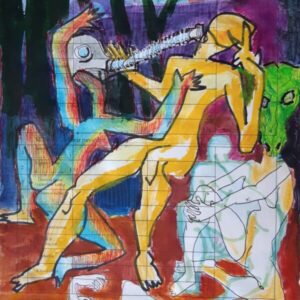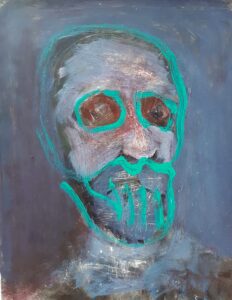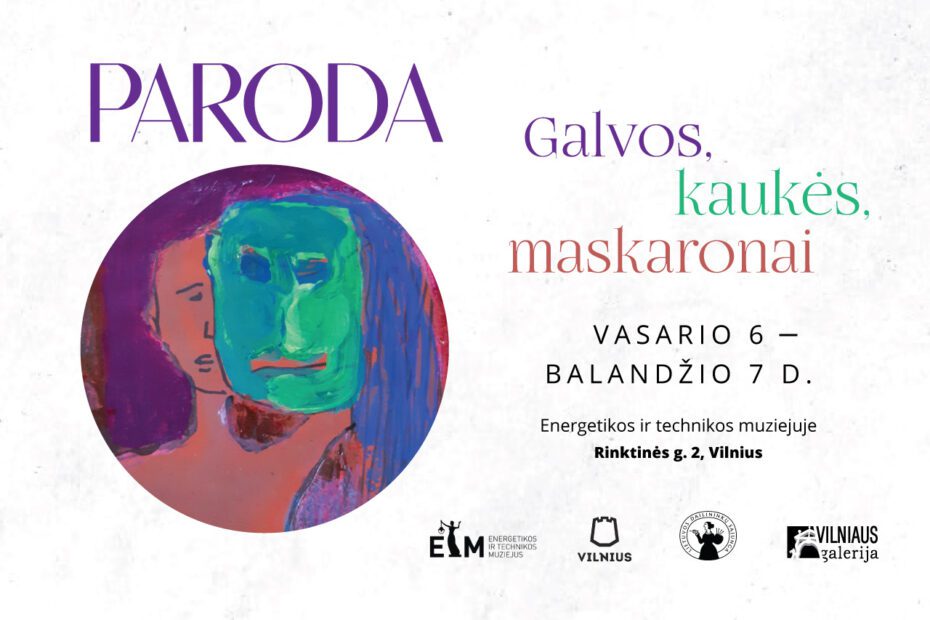On February 6th, a group exhibition “Heads, Masks, Mascarons“ opens in the Boiler Hall of the Energy and Technology Museum. Opening will take place on February 6th, at 5.30 PM.
ABOUT THE EXHIBITION
The face represents the most important organ of the human head. A multifunctional portal for the expression of intellectual psychology, where visual, auditory, sensory emotions are reflected and life support organs are functioning. It is important to have your face without a mask and not to lose your head in certain situations. So keep your heads up!


Ričardas Zdanavičius
Actors in ancient Greek theater (tragedy, comedy, satirical drama) wore large masks with expressive grimaces. Such stylized masks can be seen today on some old buildings in Vilnius – as decorative architectural elements – mascarons.
Maskaròn (French: Mascaron, Italian: macherone < maschera, mask), a mask-shaped decorative element of architecture, applied art, a grotesque image of a human head. It is usually depicted with the eyes, ears, and horns of a beast. Mascaron was used to decorate fountain openings, door knobs and keyholes, consoles and etc. Mascaron prototypes are images of mythological creatures (satyrs, winds) widespread in ancient Rome. Used in Gothic, Renaissance buildings, works of art, became popular during Mannerism, in 20th century, in applied art. (Universal Lithuanian Encyclopedia)
Covering the head and face is characteristic of the customs of various communities. The old religious traditions of Islam dictate strict requirements for clothing – for women to cover their head and whole body with a chador or burka. Other nations of the world hid their faces under a veil only during weddings or other ceremonies. Recently, the pandemic forced everyone to wear medical masks, respirators or self-isolate from death at home. Due to such a grimace of fate, one cringes at the beginning: maybe it will pass, then one rebels after suppressing negative emotions and finally reconciles. Unplanned mask performances took place in various places, the participants of which had difficulty recognizing each other or deliberately avoided eye contact due to the unusualness of the event. A person raises a question about real values, about efforts to remain authentic in today’s relationships, which are based on the simulation of feelings and superficiality.
The internal contradictions between the fighting phase and reconciliation change the physiological constitution of a person: both his appearance and psyche. The prolonged discipline of masks has somewhat disturbed the natural bonds of communication. Hiding the face under a mask has become an anomic safe cover for the individual. In most cases, you get used to it, literally and figuratively.
In the Lithuanian Mardi Gras festival, the masks worn were ličynos, men disguised themselves as women, and women as men. The participants of the masquerade festival became devils, bears, gilts, doctors, wise men, beggars and other mythical creatures while playing characters, albeit for a short time.

Today’s modern military disguises: camouflage, gas masks or mimicry clothes – are unfortunately becoming a sad everyday thing.
The predatory militaristic death machine (machina mortis) turned by one aggressive government in Russia’s war against Ukraine and partly against us is shaking the world and every sensitive citizen. This macabre time with all the anti-human physical and moral consequences of war finds an echo in the artistic community as well.
The author of the project is Ričardas Zdanavičius
◾ The exhibition will be on display from February 6th to April 7th 2024 in the Boiler Hall.
◾ Opening of the exhibition will take place on February 6th, 5.30 PM. The event is free of admission charge.
◾ Visiting the exhibition on other days is with the purchase of a museum visitor ticket.
Partners – Lithuanian Artists’ Union, Vilnius Gallery, Vilnius City Municipality, Energy and Technology Museum

